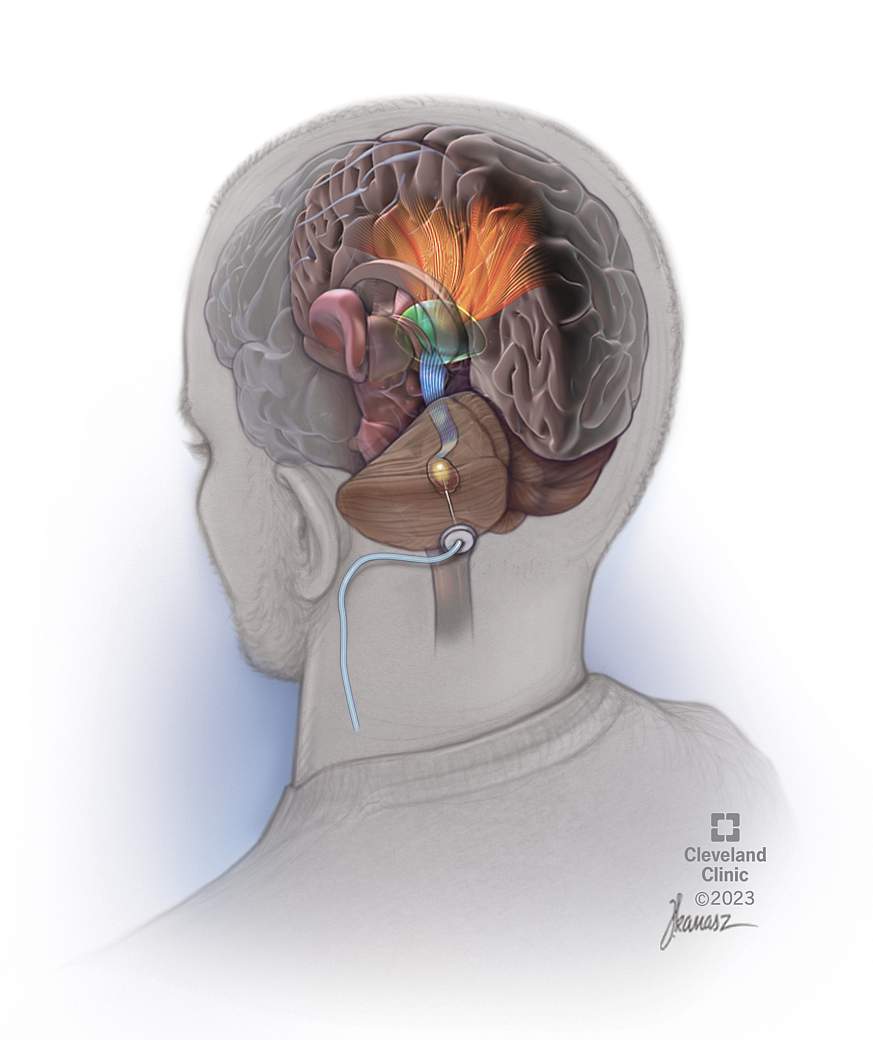You are here
Media Advisory
Monday, August 14, 2023
Cerebellar post-stroke deep brain stimulation appears safe and feasible in a small trial
Early NIH-funded trial is first step towards development of a potential stroke treatment.

What
The results of an early-stage clinical trial indicate that deep brain stimulation (DBS) applied to the cerebellum may help recovery of upper limb function following stroke. The findings, published in Nature Medicine, support the design of larger, blinded clinical trials to fully assess the benefit of such a treatment. This trial, which was conducted at the Cleveland Clinic, Cleveland, is the first-in-human test of post-stroke cerebellar DBS, supported by the National Institutes of Health’s Brain Research through Advancing Innovative Neurotechnologies Initiative, or The BRAIN Initiative.
Stroke is a leading cause of serious long-term disability. Each year in the United States, more than 800,000 strokes occur. Roughly 50% of those who survive a stroke have persistent disabilities, including neurological issues, that affect their day to day lives. While physical therapy can help improve symptoms, the benefit typically plateaus around one year after stroke.
Twelve individuals with moderate to severe upper extremity impairment following stroke were enrolled to receive DBS to an area within the cerebellum called the dentate nucleus (DN). This region was chosen because of the well-established role the cerebellum plays in motor function, as well as decades of animal studies showing the importance of the circuit connecting the DN to the motor cortex. Each participant received physical therapy before, during, and after DBS, which was delivered continuously for between four and eight months.
The primary goal of this study was to determine whether cerebellar DBS in combination with physical therapy is a safe and potentially effective treatment for post-stroke motor deficits. No serious adverse events or device failures were reported during the trial. These encouraging results support the design of larger, more rigorous clinical trials aimed at determining how effective DBS plus physical therapy is compared to just physical therapy alone.
The study’s secondary findings were also promising, with nine out of 12 participants showing improvements in motor function following DBS plus physical therapy. These improvements persisted even after DBS was turned off. Importantly, the time that had passed since the stroke occurred did not seem to affect the potential for improvement. Not all improved to the same degree. Participants who retained some level of motor function in the hand experienced clinically significant recovery. However, participants with a low level of motor function in hand showed only minimal benefit. All who had some measure of control showed improvement over the course of the treatment.
The findings of this trial, while preliminary, suggest that DBS when added to physical therapy can provide benefit to someone who has had a stroke up to three years prior. Larger, rigorous, and randomized clinical trials will be necessary to verify these findings in larger groups of patients.
This study was funded by the NIH BRAIN Initiative (UH3NS100543). The clinical trial is registered on ClinicalTrials.gov (NCT02835443)
Who
John Ngai, Ph.D., director, NIH BRAIN Initiative
Brooks Gross, Ph.D., program director, NINDS Division of Translational Research
Scott Janis, Ph.D., program director, NINDS Division of Clinical Research
To arrange an interview, please contact NINDSPressTeam@ninds.nih.gov.
Article
Baker KB, et al. “Cerebellar deep brain stimulation for chronic post-stroke motor rehabilitation: a phase I trial.” August 14, 2023. Nature Medicine.
The NIH BRAIN Initiative is managed by 10 Institutes and Centers whose missions and current research portfolios complement the goals of The BRAIN Initiative®: National Center for Complementary and Integrative Health, National Eye Institute, National Institute on Aging, National Institute on Alcohol Abuse and Alcoholism, National Institute of Biomedical Imaging and Bioengineering, Eunice Kennedy Shriver National Institute of Child Health and Human Development, National Institute on Drug Abuse, National Institute on Deafness and other Communication Disorders, National Institute of Mental Health, and National Institute of Neurological Disorders and Stroke.
NINDS is the nation’s leading funder of research on the brain and nervous system. The mission of NINDS is to seek fundamental knowledge about the brain and nervous system and to use that knowledge to reduce the burden of neurological disease.
About the National Institutes of Health (NIH): NIH, the nation's medical research agency, includes 27 Institutes and Centers and is a component of the U.S. Department of Health and Human Services. NIH is the primary federal agency conducting and supporting basic, clinical, and translational medical research, and is investigating the causes, treatments, and cures for both common and rare diseases. For more information about NIH and its programs, visit www.nih.gov.
NIH…Turning Discovery Into Health®
